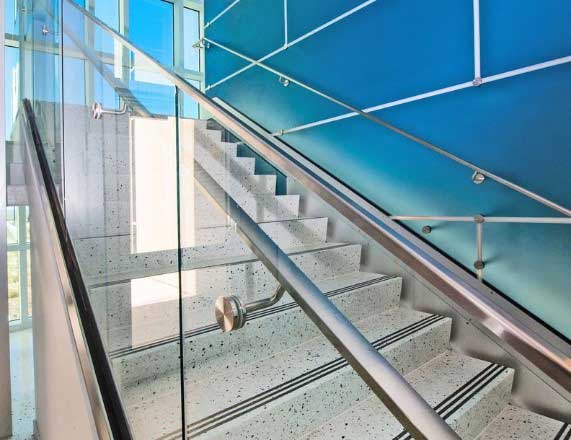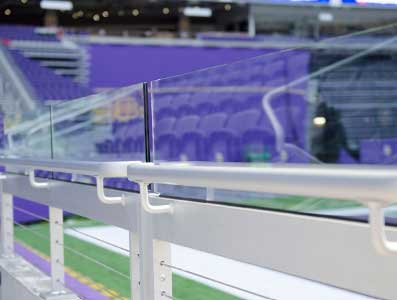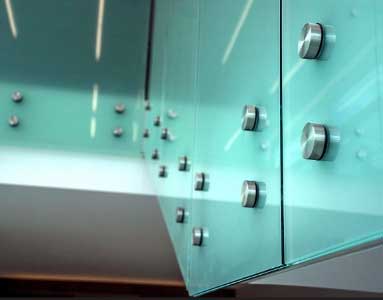Tony Barnes provides a comprehensive history of code as it pertains to glass guardrail, detailing how and why the code has evolved.

Author: Anthony J. Barnes, Director of Structural Engineering for Sightline Commercial Solutions
Contributors: Melissa Szotkowski, Structural Glass Systems Manager for Oldcastle BuildingEnvelope and Bryan Wedan, Director of Design Engineering for Enclos
The engineering of guardrails has historically been done in a fairly straightforward manner. The requirements are few and have not changed tremendously over the last 50 years. Glass guardrail provisions are also few in number and have remained fairly static for about 30 years. Having been involved in the industry for much of this period, I have gained insight and experience that qualify me as a bit of a subject matter expert. I also have had the benefit of connecting and collaborating with other experts on this topic, two of whom graciously contributed to this article, which takes an in-depth look at the history of code as it pertains to guardrail and, more specifically, glass guardrail. It also will address how and why the code has evolved over time and some possibilities and projections for where it may go in the future.
First, let’s review the history of sources for structural requirements for guards, specifically for live load requirements. The first concise and authoritative document addressing live loads appears to have been the “Minimum Live Loads Allowable For Use in Design of Buildings,” published by the United States Department of Commerce in 1925. The stated purpose of this document was to create standards for the application of live loads based on collected data. The introduction states that live loads assumed in designing many types of buildings were largely matters of tradition and had scant scientific basis. There was a clear need to address a gap in safety. This document evolved over the next several decades and was eventually published again under the supervision of the U.S. Department of Commerce’s National Standards Bureau and the American Standards Association as American Standard (ASA) A58.1 in 1945. The first mention of a railing load requirement of 50 pounds per linear foot applied at the top of the railing appears to be within this document. ASA eventually became American National Standards Institute (ANSI), and this document eventually became ASCE 7, the document referenced in the International Building Code (IBC) for determining loads on structures. The 200-pound concentrated load applied to railings was added to railing requirements in the 1988 version of ASCE 7.
Now, let’s look at the background of glass use in guards. While building codes were evolving, building material technology was also rapidly advancing, making glass a viable structural material. First, heat strengthening methods were developed that could quadruple the strength of glass. Next, glass manufacturing methods drastically improved between the middle of the 19th century and the middle of the 20th century. Quality, economically produced, float glass was available by the early 1960s. Lastly, laminated glass became widely available by the early-to-mid 20th century, primarily for use in the auto industry. It was intuitively understood that the physical properties of glass were different from those of other traditional building materials such as steel, wood, or reinforced concrete. Glass was brittle and failed suddenly. Since the 1960s, window and skylight glass used in the construction industry had generally been designed using a simple chart that was based on destructive glass tests. These tests included various aspect ratios and glass thicknesses but did not consider anything other than 4-side supported rectangular plates. This method was widely accepted and likely resulted in safe and sufficient designs for nearly all applications of glass at that time (i.e., windows).
A more general method was sought to predict glass failure, and W. Lynn Beason published a study introducing a glass failure model employing the work of Ernst Hjalmar Waloddi Weibull, who in 1939 offered a statistical failure analysis for predicting the strength of brittle materials. This became the basis for discussion within the American Society for Testing and Materials, out of which was born ASTM E 1300 Annealed Glass Thickness Selection Charts in 1989. Charts provided allowable loads on flat glass supported on edges. This document was eventually referenced by the IBC for determining wind, snow, seismic and dead load resistance of glazing. E 1300 has been expanded and revised several times over the years to address such things as heat-strengthened glass, laminated glass, and insulating glass. Note that early versions of this standard did not explicitly prevent its application to glass guards, but more recent versions have stated that the practice excludes balustrades. Appendices in the document allow for the derivation of permissible glass stresses. These derived stresses have been commonly used by engineers to determine allowable stresses that could be used as limits for conditions outside the scope of E 1300, such as discrete support points on glass, non-rectangular shaped glass, non-uniform loads, etc.
The guidance specific to glass used in guards was first published in the 1988 version of the United Building Code (UBC). Note that this was published one year prior to the publication of ASTM E 1300 and certainly a few years before any of the model codes such as UBC, SBC or others were referencing E 1300. Bill Lingnell PE, of Lingnell Consulting Services, happens to be the historian on this subject matter (1) and was an original member of the group that created ASTM E 1300. He was also involved in empirical glass tests used to justify design prior to E 1300. Bill graciously spoke to me and provided a wealth of historical knowledge. Not coincidentally, he was the person whom code authorities contacted to provide a safe limit for use in glass guards in the late 1980s. Based on what he knew from testing and from his work with the probabilistic methods of E 1300, a simple statement regarding glass guard design was published in UBC 1988. This simple statement was, “A safety factor of 4 shall be used.”
This language remains to this day in the 2021 International Building Code, albeit with a few very minor alterations that have not changed the spirit of the statement. The requirement, at first glance, seems simple enough. However, it is a bit ambiguous and results in some differing interpretations that I’ve seen over the years:
To an engineer familiar with glass design, intuitively the answer is to obtain a glass strength, divide that number by four, and use this value as the allowable glass stress. To the manufacturer of glass railing seeking product approval, the directive seems to be to apply four times the load in a test. And, finally, to the code official, the instruction is, conservatively, to use a factor of safety of four and apply it, either in test or analysis, to both the glass and to the supports.
When we began to work on glass guards in 2014, the approach was to use the most commonly known value for the modulus of rupture of glass, taken from AAMA CW-12-84, and divide that value by four. From experience, it was obvious that this factor of safety need only be applied to glass, not the support system for the glass. Some jurisdictional authorities thought differently, and I thus asked the International Code Council (ICC, those responsible for the publication of IBC) for a clarification. The response was that a) glass need not be tested with 4x the design load (this was later clarified in code commentary), and that b) supports directly supporting glass do need to be designed with a factor of safety of four. The folks at ICC agreed that the language could use some clarification, and if I so desired, I could submit a code change proposal. Thus began my naïve journey into modifying the code.
In 2018 I wrote a very simple proposal for the 2021 code cycle, which sought to clarify to what the factor of safety of four should be applied. Eventually, through negotiation within ICC committees and consultation within a group of technical experts, the proposal was modified to provide an allowable stress level for guard rail glass derived using the methods of E 1300. The changes seemed very reasonable and logical in my engineering brain, but that didn’t translate to changes easy to digest and accept by the glass industry and the body of ICC. What sounds like the end of my foray into code work turns out to be the beginning.


What is the future of glass guard code? With the 2021 code cycle behind us, the next deadline would be for the 2024 code cycle. What I had learned from my first attempt was that the body of ICC consists of municipal building officials, industry lobbyists, manufacturers and technical experts. The majority of decision makers are code officials that sit on various committees, but representatives of industry interests generally keep a keen eye out for things that could negatively impact their industries.
A code provision change first needs the support of the specific committee, so you must convince them that your idea is palatable (in the case of guardrail provisions, the structural committee). Then you need to convince appropriate industry representatives that the impact is positive, so they don’t speak against your proposal. Once I started to connect the dots, it was determined through communication with people in the glass industry and those on the ICC structural committee that the best course of action would be to connect with people in ASTM because a work group had already undertaken the writing of a glass guard standard. The idea was to get a standard published in time for it to be referenced in the 2024 version of IBC. I felt extremely positive at this point, with three years ahead of us. I prematurely and naively assumed we had achieved a panacea that could easily be implemented in time for the 2021 deadline for code change proposals.
Needless to say, I was wrong, and the deadline to adopt an ASTM standard for the 2021 building code was missed. Instead, in the 11th hour, technical folks and industry advocates came together to enter a code change proposal that simply suggested allowable stress values for glass used in guards. This proposal eliminated any mention of the factor of safety of four and clearly decoupled glass and the supporting structure. Although this proposed language suffices to provide clarity of intent, I truly believe that the most reasonable technical approach to the design for glass guards is to use a method similar to that of ASTM E 1300; i.e., a probabilistic mathematical method. Ironically, without any mention of glass guard capacity in building code, an engineer would simply use ASTM E 1300 methods to derive an allowable glass stress and compare that to resultant stresses generated by the application of the code-prescribed loads. Of course, the issue has been that the code language developed in 1988 specifying guard capacity (factor of safety of four) was published prior to the publishing of ASTM E 1300.
The alternative to the current process would be to include reference to an ASTM standard in the building code. This method has advantages. It reduces the amount of prescriptive language in code, and an adoption of a standard by the building code implies a certain amount of trust in the standard organization to responsibly provide future guidance. The ASTM committees can be more agile than building code bodies and can adopt future changes as technologic developments occur or as design considerations need to be addressed.
Ultimately, I believe it would be ideal to have a glass construction manual referenced by building code – i.e., a document similar to AISC 360 or ACI 318 – a specification that would cover all glass design. Of course, for this to occur, an organization or group of people are needed to offer their support. Currently, there is a document published in 2018 by the National Council of Structural Engineers Associations (NCSEA), “Engineering Structural Glass Design Guide,” that could serve as a foundation for this purpose. Further, based on current code/industry precedent (that is, having material-specific trade organizations sponsor these publications), it seems as though this type of effort would be best led by a group such as The National Glass Association (NGA), which combined with the Glass Association of North America (GANA) in 2018. This industry alliance already supports technical workgroups that have written white papers and other design guides on specific topics related to glass. It is clear, in any case, and in referencing my own experience, that this will take an ambitious and dedicated effort.
Bibliography
About the Author
Anthony (Tony) Barnes is Director of Structural Engineering for Minneapolis-based Sightline Commercial Solutions, a leading fabricator and global supplier of architectural railing, metal, glazing and portable platform solutions for the commercial, sports venue, live entertainment and performing arts industries. With more than three decades of experience working with glaziers, architects, general contractors and installers, the company specializes in providing innovative solutions for the most complex challenges. For more information visit https://www.sightlinecommercial.com.
In this episode, I sat down with Beejan Giga, Director | Partner and Caleb Emerson, Senior Results Manager at Carpedia International. We discussed the insights behind their recent Industry Today article, “Thinking Three Moves Ahead” and together we explored how manufacturers can plan more strategically, align with their suppliers, and build the operational discipline needed to support intentional, sustainable growth. It was a conversation packed with practical perspectives on navigating a fast-changing industry landscape.